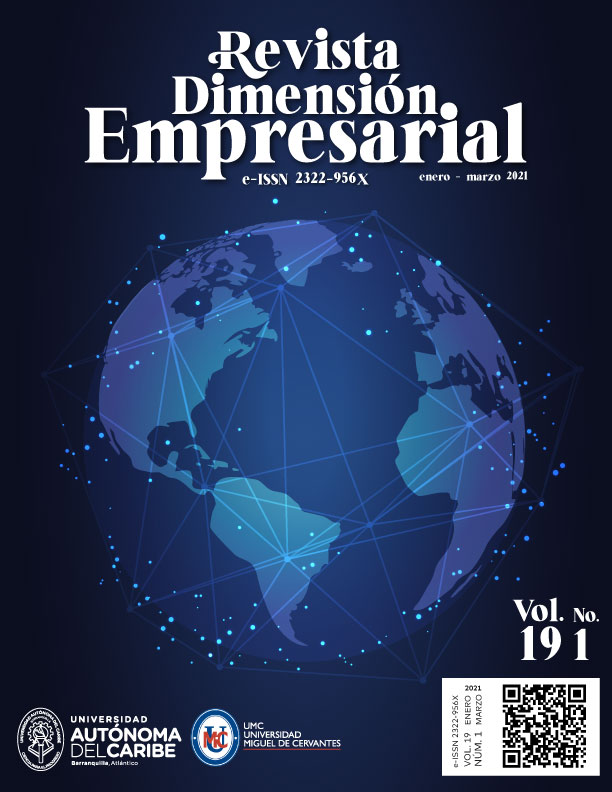Impacto da capacidade de absorção e ambidestria na inovação Javier Fernando
DOI:
https://doi.org/10.15665/dem.v19i1.2616Palavras-chave:
capacidade de absorção, ambidestria, inovação tecnológica, manufaturaResumo
Este estudo tenta desenhar uma abordagem que mostre como a capacidade de absorção e a ambidestria estão relacionadas à inovação tecnológica nas empresas manufatureiras peruanas. Um modelo de equação estrutural é proposto. A amostra é composta por 783 empresas manufatureiras. Verificou-se que embora as empresas manufatureiras peruanas investem pouco em pesquisa e desenvolvimento, elas são capazes de desenvolver capacidades dinâmicas, como capacidade de absorção e ambidestria, para melhor realizar a inovação tecnológica.
Referências
Aguilera, R. V., Ciravegna, L., Cuervo-Cazurra, A., & Gonzalez-Perez, M. A. (2017). Multilatinas and the internationalization of Latin American firms. Journal of World Business, 52(4), 447-460. DOI: https://doi.org/10.1016/j.jwb.2017.05.006
Aljanabi, A. R. A., & Mohd Noor, N. A. (2015). The mediating role of market orientation on entrepreneurial orientation, absorptive capacity and technological innovation capabilities. Asian Social Science, 11(5), 219-234. DOI: https://doi.org/10.5539/ass.v11n5p219
Aryasa, K. B., Wahyuni, S., Sudhartio, L., & Wyanto, S. H. (2017). The impact of absorptive capacity, organizational inertia on alliance ambidexterity and innovation for sustained performance. Academy of Strategic Management Journal, 16(3), 1-19.
Byrne, B. M. (2010). Structural equation modeling with AMOS: Basic concepts, applications, and programming (2nd. ed.). Routledge. DOI: https://doi.org/10.4324/9781410600219
Cabeza-Pullés, D., Fernández-Pérez, V., & Roldán-Bravo, M. I. (2020). Internal networking and innovation ambidexterity: The mediating role of knowledge management processes in university research. European Management Journal, 38(3), 450-461. DOI: https://doi.org/10.1016/j.emj.2019.12.008
Camisón, C., & Villar-López, A. (2014). Organizational innovation as an enabler of technological innovation capabilities and firm performance. Journal of Business Research, 67(1), 2891-2902. DOI: https://doi.org/10.1016/j.jbusres.2012.06.004
Chang, Y., Hughes, M., & Hotho, S. (2011). Internal and external antecedents of SMEs’ innovation ambidexterity outcomes, Management Decision, 49(10), 1658-1676. https://doi.org/10.1108/00251741111183816
Cao, Q., Gedajlovic, E., & Zhang, H. (2009). Unpacking organizational ambidexterity: Dimensions, contingencies, and synergistic effects. Organization Science, 20(4), 781-796. DOI: https://doi.org/10.1287/orsc.1090.0426
Cohen, W. M., & Levinthal, D. A. (1990). Absorptive capacity: A new perspective on learning and innovation. Administrative Science Quarterly, 35(1), 128-152. DOI: https://doi.org/10.2307/2393553
Del Carpio-Gallegos, J. F., & Miralles-Torner, F. (2018). Absorptive capacity and innovation in low-tech companies in emerging economies. Journal of Technology Management & Innovation, 13(2), 3-11. DOI: https://doi.org/10.4067/s0718-27242018000200003
Derbyshire, J. (2014). The impact of ambidexterity on enterprise performance: Evidence from 15 countries and 14 sectors. Technovation, 34(10), 574-581. DOI: https://doi.org/10.1016/j.technovation.2014.05.010
Diaz-Molina, I. (2018). The role of strategic and operational absorptive capacity in organizational ambidexterity [Conference session]. 2018 Engaged Management Scholarship Conference, Temple University, Philadelphia, PA, United States. DOI: https://doi.org/10.2139/ssrn.3235526
Dutta, S. K. (2013). Market orientation ambidexterity. SCMS Journal of Indian Management, 10(1), 54.
Escribano, A., Fosfuri, A., & Tribó, J. A. (2009). Managing external knowledge flows: The moderating role of absorptive capacity. Research Policy, 38(1), 96-105. DOI: https://doi.org/10.1016/j.respol.2008.10.022
Fernandez, V. (2017). The finance of innovation in Latin America. International Review of Financial Analysis, 53, 37-47. DOI: https://doi.org/10.1016/j.irfa.2017.08.008
Fornell, C., & Larcker, D. F. (1981). Evaluating structural equation models with unobservable variables and measurement error. Journal of Marketing Research, 18(1), 39–50. DOI: https://doi.org/10.2307/3151312
Gibson, C. B., & Birkinshaw, J. (2004). The antecedents, consequences, and mediating role of organizational ambidexterity. Academy of Management Journal, 47(2), 209-226. DOI: https://doi.org/10.5465/20159573
Gregson, G. (2020). Innovation systems and entrepreneurial ecosystems: Implications for policy and practice in Latin America. Academy of Management Global Proceedings, 301. DOI: https://doi.org/10.1177/0269094219896096
Gunday, G., Ulusoy, G., Kilic, K., & Alpkan, L. (2011). Effects of innovation types on firm performance. International Journal of production economics, 133(2), 662-676. DOI: https://doi.org/10.1016/j.ijpe.2011.05.014
Hair, J. F., Black, W. C., Babin, B. J., & Anderson, R. E. (2010). Multivariate data analysis (7th ed.). Prentice Hall.
Hair Jr., J. F., Sarstedt, M., Hopkins, L., & Kuppelwieser, V. G. (2014). Partial least squares structural equation modeling (PLS-SEM). European Business Review. 2(6), 106-121. DOI: https://doi.org/10.1108/ebr-10-2013-0128
He, Z. L., & Wong, P. K. (2004). Exploration vs. exploitation: An empirical test of the ambidexterity hypothesis. Organization Science, 15(4), 481-494. DOI: https://doi.org/10.1287/orsc.1040.0078
Ince, H., Imamoglu, S. Z., & Turkcan, H. (2016). The effect of technological innovation capabilities and absorptive capacity on firm innovativeness: A conceptual framework. Procedia-Social and Behavioral Sciences, 235, 764-770. DOI: https://doi.org/10.1016/j.sbspro.2016.11.078
Koçoglu, I., Akgün, A. E., & Keskin, H. (2015). The differential relationship between absorptive capacity and product innovativeness: A theoretically derived framework. International Business Research, 8(7), 108. DOI: https://doi.org/10.5539/ibr.v8n7p108
Laursen, K., & Salter, A. (2006). Open for innovation: The role of openness in explaining innovation performance among U.K. manufacturing firms. Strategic Management Journal, 27, 131–150. doi: 10.1002/smj.507 DOI: https://doi.org/10.1002/smj.507
Lavie, D., Stettner, U., & Tushman, M. L. (2010). Exploration and exploitation within and across organizations. The Academy of Management Annals, 4(1), 109-155. DOI: https://doi.org/10.5465/19416521003691287
Liao, S., Liu, Z., & Zhang, S. (2018). Technology innovation ambidexterity, business model ambidexterity, and firm performance in Chinese high-tech firms. Asian Journal of Technology Innovation, 26(3), 325-345. DOI: https://doi.org/10.1080/19761597.2018.1549954
Limaj, E., Bernroider, E. W., & Choudrie, J. (2016). The impact of social information system governance, utilization, and capabilities on absorptive capacity and innovation: A case of Austrian SMEs. Information & Management, 53(3), 380-397. DOI: https://doi.org/10.1016/j.im.2015.12.003
Lin, H. E., McDonough III, E. F., Lin, S. J., & Lin, C. Y. Y. (2013). Managing the exploitation/exploration paradox: The role of a learning capability and innovation ambidexterity. Journal of Product Innovation Management, 30(2), 262-278. DOI: https://doi.org/10.1111/j.1540-5885.2012.00998.x
Lucena, A., & Roper, S. (2016). Absorptive capacity and ambidexterity in R&D: Linking technology alliance diversity and firm innovation. European Management Review, 13(3), 159-178. DOI: https://doi.org/10.1111/emre.12074
Mardi, M., Arief, M., Furinto, A., & Kumaradjaja, R. (2018). Sustaining organizational performance through organizational ambidexterity by adapting social technology. Journal of the Knowledge Economy, 9(3), 1049-1066. DOI: https://doi.org/10.1007/s13132-016-0385-5
Martinez-Senra, A. I., Quintas, M. A., Sartal, A., & Vázquez, X. H. (2015). How can firms’ basic research turn into product innovation? The role of absorptive capacity and industry appropriability. IEEE Transactions on Engineering Management, 62(2), 205-216. DOI: https://doi.org/10.1109/tem.2014.2386614
Najafi-Tavani, S., Najafi-Tavani, Z., Naudé, P., Oghazi, P., & Zeynaloo, E. (2018). How collaborative innovation networks affect new product performance: Product innovation capability, process innovation capability, and absorptive capacity. Industrial Marketing Management, 73, 193-205.DOI: https://doi.org/10.1016/j.indmarman.2018.02.009
Olavarrieta, S., & Villena, M. G. (2014). Innovation and business research in Latin America: An overview. Journal of Business Research, 67(4), 489-497. DOI: https://doi.org/10.1016/j.jbusres.2013.11.005
O’Reilly III, C. A., & Tushman, M. L. (2008). Ambidexterity as a dynamic capability: Resolving the innovator’s dilemma. Research in Organizational Behavior, 28, 185-206. DOI: https://doi.org/10.2139/ssrn.978493
Pelagio Rodriguez, R., Hechanova, M., & Regina, M. (2014). A study of culture dimensions, organizational ambidexterity, and perceived innovation in teams. Journal of Technology Management & Innovation, 9(3), 21-33. DOI: https://doi.org/10.4067/s0718-27242014000300002
Rammer, C., Czarnitzki, D., & Spielkamp, A. (2009). Innovation success of non-R&D-performers: Substituting technology by management in SMEs. Small Business Economics, 33(1), 35-58. DOI: https://doi.org/10.2139/ssrn.1314246
Revilla, E., Prieto, I. M., & Rodríguez, B. (2011). Information technology and the ambidexterity hypotheses: An analysis in product development. Journal of Operations and Supply Chain Management (JOSCM), 4(2), 1-18. DOI: https://doi.org/10.2139/ssrn.1002973
Schoenmakers, W., & Duysters, G. (2006). Learning in strategic technology alliances. Technology Analysis & Strategic Management, 18(2), 245–264. DOI: https://doi.org/10.1080/09537320600624162
Solís-Molina, M., Hernández-Espallardo, M., & Rodríguez-Orejuela, A. (2018). Performance implications of organizational ambidexterity versus specialization in exploitation or exploration: The role of absorptive capacity. Journal of Business Research, 91, 181-194. DOI: https://doi.org/10.1016/j.jbusres.2018.06.001
Thornhill, S. (2006). Knowledge, innovation and firm performance in high-and low-technology regimes. Journal of Business Venturing, 21(5), 687-703. DOI: https://doi.org/10.1016/j.jbusvent.2005.06.001
Vrontis, D., Thrassou, A., Santoro, G., & Papa, A. (2017). Ambidexterity, external knowledge and performance in knowledge-intensive firms. The Journal of Technology Transfer, 42(2), 374-388. DOI: https://doi.org/10.1007/s10961-016-9502-7
Wang, C. L., & Rafiq, M. (2014). Ambidextrous organizational culture, contextual ambidexterity and new product innovation: A comparative study of UK and Chinese high‐tech firms. British Journal of Management, 25(1), 58-76. DOI: https://doi.org/10.1111/j.1467-8551.2012.00832.x
Wei, Z., Yi, Y., & Guo, H. (2014). Organizational learning ambidexterity, strategic flexibility, and new product development. Journal of Product Innovation Management, 31(4), 832-847. DOI: https://doi.org/10.1111/jpim.12126
Wong, C. W., Wong, C. Y., & Boon-itt, S. (2013). The combined effects of internal and external supply chain integration on product innovation. International Journal of Production Economics, 146(2), 566-574. DOI: https://doi.org/10.1016/j.ijpe.2013.08.004
Zhao, X., Lynch, J. G., Jr., & Chen, Q. (2010). Reconsidering Baron and Kenny: Myths and truths about mediation analysis. Journal of Consumer Research, 37(2), 197-206. doi: 10.1086/651257 DOI: https://doi.org/10.1086/651257
Zou, T., Ertug, G., & George, G. (2018). The capacity to innovate: A meta-analysis of absorptive capacity. Innovation, 20(2), 87-121. DOI: https://doi.org/10.1080/14479338.2018.1428105
##submission.downloads##
Publicado
Como Citar
Edição
Secção
Licença
Direitos de Autor (c) 2021 Javier Fernando Del Carpio Gallegos, Francesc Miralles, Eduardo Javier Soria Gomez

Este trabalho encontra-se publicado com a Licença Internacional Creative Commons Atribuição-NãoComercial-SemDerivações 4.0.
Os autores mantêm todos os direitos a que têm direito e autorizadas com a sua reprodução de assinatura gratuita do documento enviado ou, no caso se necessário, assumirá, ao assinar o Certificado de Originalidade e Cessão de Direitos, o registro de ter a autoridade para a transferência de direitos de propriedade que estão livres devido a nenhum custo para qualquer procedimento do Dimensión Empresarial.
Instruções para preenchimento Originalidade Certificação e Transferência de Direitos de autor.
1. Clique aqui e tenha a originalidade da forma Certification and Copyright Assignment.
2. No formulário baixo, clique em cada um os campos e preencha os correspondentes.
3. Uma vez que os campos estão preenchidos, copie o fim sua assinatura digitalizada ou assinatura digital. Por favor, ajustar o tamanho da assinatura no formulário.
4. O formulário deve ser assinado por todos os autores.
5. Finalmente, salvá-lo como PDF e enviá-lo através da plataforma OJS como arquivo suplementar ou correio revistadimensionempresarial@uautonoma.edu.co.
Se você tiver dúvidas contate-nos, por favor.



